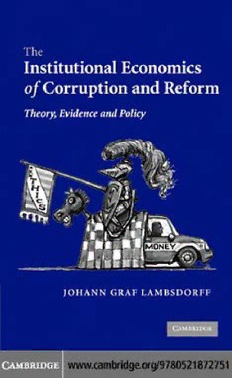
The institutional economics of corruption and reform PDF
Preview The institutional economics of corruption and reform
This page intentionally left blank The Institutional Economics of Corruption and Reform Theory, Evidence, and Policy Corruption has been a feature of public institutions for centuries, yet only relatively recently has it been made the subject of sustained sci- entific analysis. In an important contribution to this ongoing project, Johann Graf Lambsdorff shows how insights from institutional eco- nomicscanbeusedtodevelopabetterunderstandingoftheinstitutions necessarytocarryoutcorrupttransactionsandthosethatarehelpfulin inhibitingthem.Hearguesthatratherthanbeingdeterredbypenalties, corrupt actors are more influenced by other factors such as the opportunismoftheircriminalcounterpartsandthedangerofacquiring areputationofunreliability.Thissuggestsanovelstrategyforfighting corruption–the‘‘invisiblefoot’’–wherebytheunreliabilityofcorrupt counterpartsinduceshonestyandgoodgovernanceevenintheabsence of good intentions. Combining interdisciplinary theoretical research with state-of-the-art empirical investigations, this book will be an invaluable resourceforresearchers and policy-makersconcernedwith anticorruption reform. johann graf lambsdorff is Chair in Economic Theory at the University of Passau, Germany, and Senior Research Consultant to Transparency International. He is the founder of the Corruption Perceptions Index, Which he has orchestrated since 1995. The Institutional Economics of Corruption and Reform Theory, Evidence, and Policy JOHANN GRAF LAMBSDORFF CAMBRIDGEUNIVERSITYPRESS Cambridge, New York, Melbourne, Madrid, Cape Town, Singapore, São Paulo Cambridge University Press The Edinburgh Building, Cambridge CB2 8RU, UK Published in the United States of America by Cambridge University Press, New York www.cambridge.org Information on this title: www.cambridge.org/9780521872751 ©JohannGrafLambsdorff2007 This publication is in copyright. Subject to statutory exception and to the provision of relevant collective licensing agreements, no reproduction of any part may take place without the written permission of Cambridge University Press. First published in print format 2007 ISBN-13 978-0-511-27418-3 eBook (EBL) ISBN-10 0-511-27418-1 eBook (EBL) ISBN-13 978-0-521-87275-1 hardback ISBN-10 0-521-87275-8 hardback Cambridge University Press has no responsibility for the persistence or accuracy of urls for external or third-party internet websites referred to in this publication, and does not guaranteethatanycontentonsuchwebsitesis,orwillremain,accurateorappropriate. To Maria, Philipp, Frederik, and Felix Contents List of boxe s page viii Acknowledegements ix A roadmap to this book xi 1 Introduction 1 2 Enemies of corruption 27 3 What is bad about bureaucratic corruption? An institutional economic approach 58 4 The dilemma of the kleptocrat: What is bad about political corruption? 81 5 Corruption and transactions costs: The rent-seeking perspective 109 6 Making corrupt deals: contracting in the shadow of the law 136 7 Exporters’ ethics and the art of bribery 164 8 How confidence facilitates illegal transactions: An empirical approach 190 9 Corrupt relational contracting 209 10 Concluding thoughts 225 Appendix: Technical details to the Transparency International Corruption Perceptions Index 236 References 256 Subject index 282 vii List of boxes Box 1 Corruption and the size of the public sector page 4 Box 2 Corruption and decentralization 6 Box 3 Corruption and regulatory quality 10 Box 4 Corruption and competition among private firms 12 Box 5 Sources of the 2005 Corruption Perceptions Index 21 Box 6 Corruption and trust 29 Box 7 Corruption, values, and colonialism 32 Box 8 Corruption and gender 34 Box 9 Corruption and geographic preconditions 35 Box 10 Corruption and official wages 37 Box 11 Corruption and democracy 39 Box 12 Corruption and parliamentarism 41 Box 13 Corruption and voting systems 43 Box 14 Corruption and press freedom 46 Box 15 Corruption and the judiciary 47 Box 16 Corruption and income per head 72 Box 17 Corruption and growth of GDP 73 Box 18 Corruption, productivity, and quality 76 Box 19 Corruption and distorted budget allocation 88 Box 20 Corruption and inequality 91 Box 21 Corruption and the underground economy 95 Box 22 Corruption and investments 100 Box 23 Corruption and the composition of investments 104 Box 24 Different types of corruption and investment 105 Box 25 How to fix a football match, by Declan Hill 169 Box 26 Corruption distorting the private sector 174 Box 27 Hindering corrupt intermediaries 184 Box 28 Fighting corruption with asymmetric penalties, jointly written with Mathias Nell 229 viii
